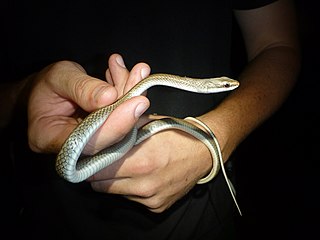
Culpepper Island is a tiny rock (island) in the Atlantic Ocean close to Bayfield and Ragged Point in Saint Philip, Barbados. The island is uninhabited.
The Barbados racer, also commonly known as the tan ground snake, was a species of colubrid snake that was endemic to Barbados.
The Sombrero ameiva is a lizard species in the genus Ameiva. It is endemic to Sombrero, a small, uninhabited island in the Lesser Antilles under the jurisdiction of Anguilla.

Pholidoscelis plei, known commonly as the Anguilla Bank ameiva or the Caribbean ameiva, is a species of lizard in the family Teiidae. The species is found on the Caribbean islands of Anguilla, Saint Martin, and Saint Barthélemy in the Lesser Antilles. Its coloration and markings vary between each island population. Two subspecies are recognized as being valid, including the nominotypical subspecies.

The Barbados anole is a species of anole lizard that is native to Barbados, an island-nation in the Caribbean. Originally endemic to Barbados, it has since been introduced to Saint Lucia and Bermuda. It was previously treated as a subspecies of Martinique's anole, A. roquet.

The fantastic least gecko, or fantastic sphaero is a species of gecko found in the Caribbean, on the islands of Dominica, Montserrat, and the Guadeloupe archipelago.
Vincent's least gecko is a species of lizard in the family Sphaerodactylidae. The species is endemic to the Caribbean.

Barbour's tropical racer is a species of snake in the family Colubridae. The species is endemic to the Caribbean.

Anolis gingivinus, also known as the Anguilla Bank tree anole, Anguilla bank anole, and Anguilla anole, is a species of anole lizard that is endemic to the Caribbean Lesser Antilles islands of Anguilla and its satellites, such as Saint Martin, and Saint Barthélemy.

The Saba least gecko is a gecko endemic to the Lesser Antilles in the Caribbean, where it can be found on Saba, Sint Eustatius, Saint Kitts, and Nevis.

The Antilles leaf-toed gecko, also known as the Maria Islands leaf-toed gecko or spiny gecko, is a gecko species found in northern South America and the Lesser Antilles. It can be found on small rocks and islets offshore of Saint Lucia, Trinidad, and Tobago, though it is absent from the main islands.
Sphaerodactylus kirbyi, commonly known as the Bequia dwarf gecko, the Bequia sphaero, or the Grenadines sphaero, is a species of gecko, a lizard in the family Sphaerodactylidae. The species is endemic to Bequia, an island in the Grenadines that is part of Saint Vincent and the Grenadines.









